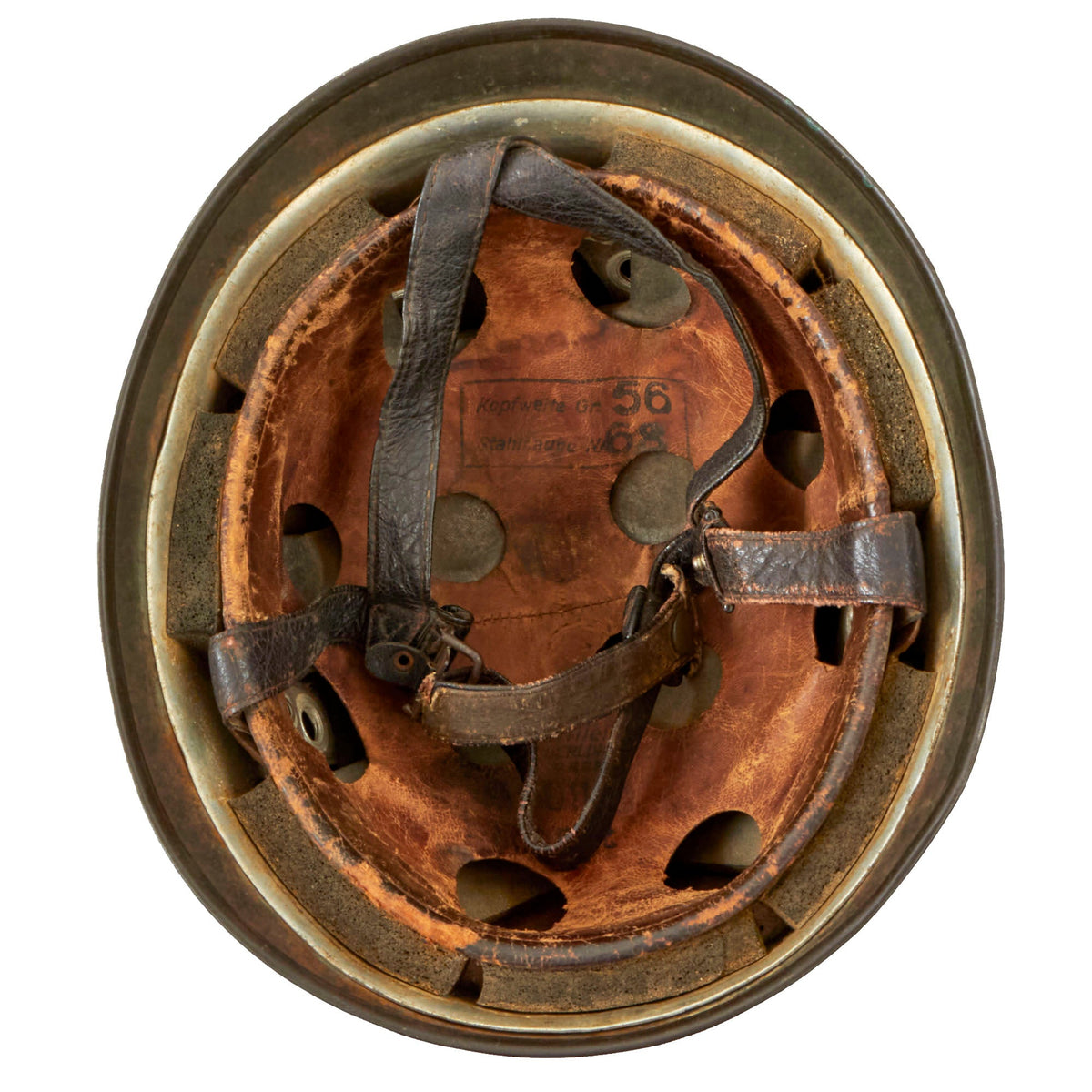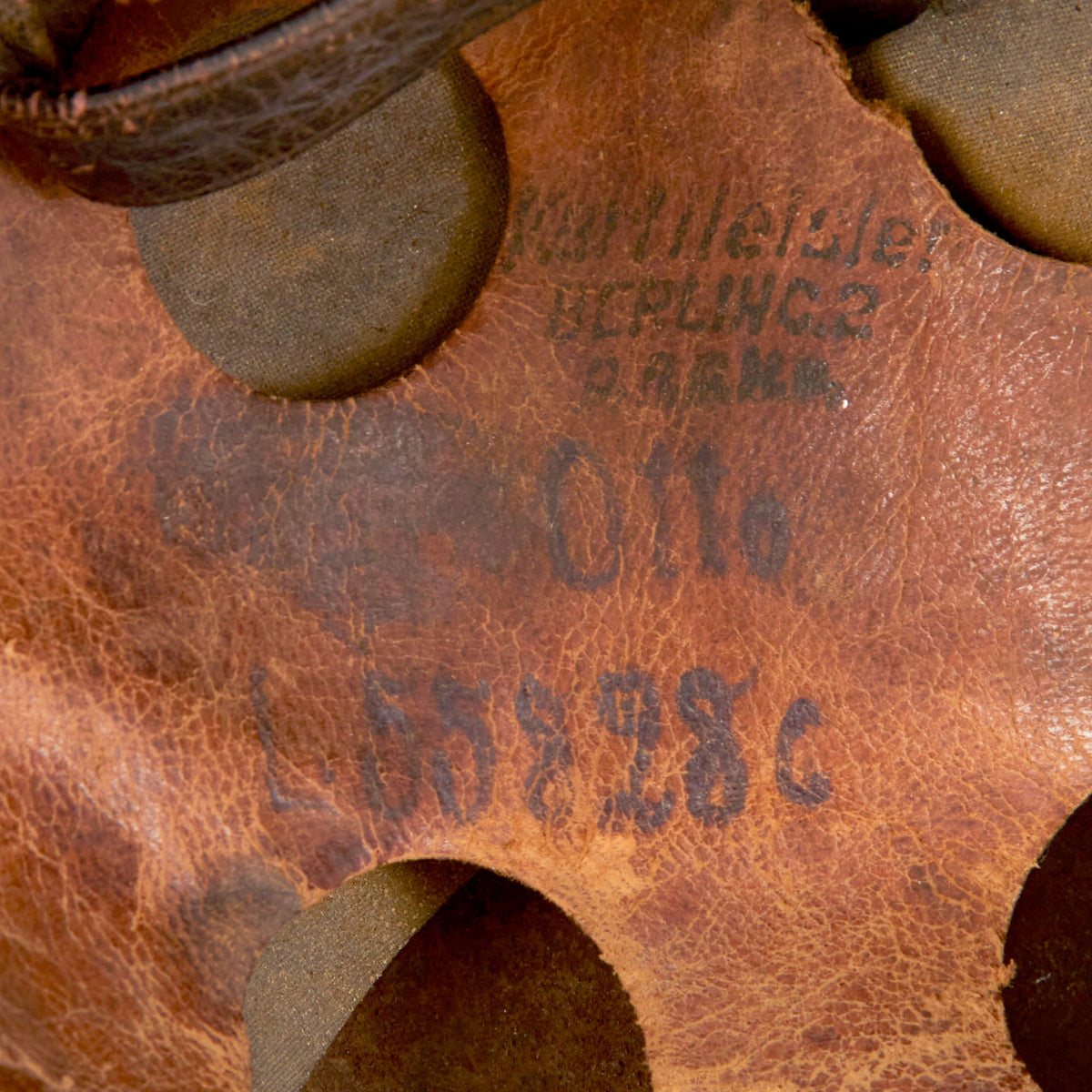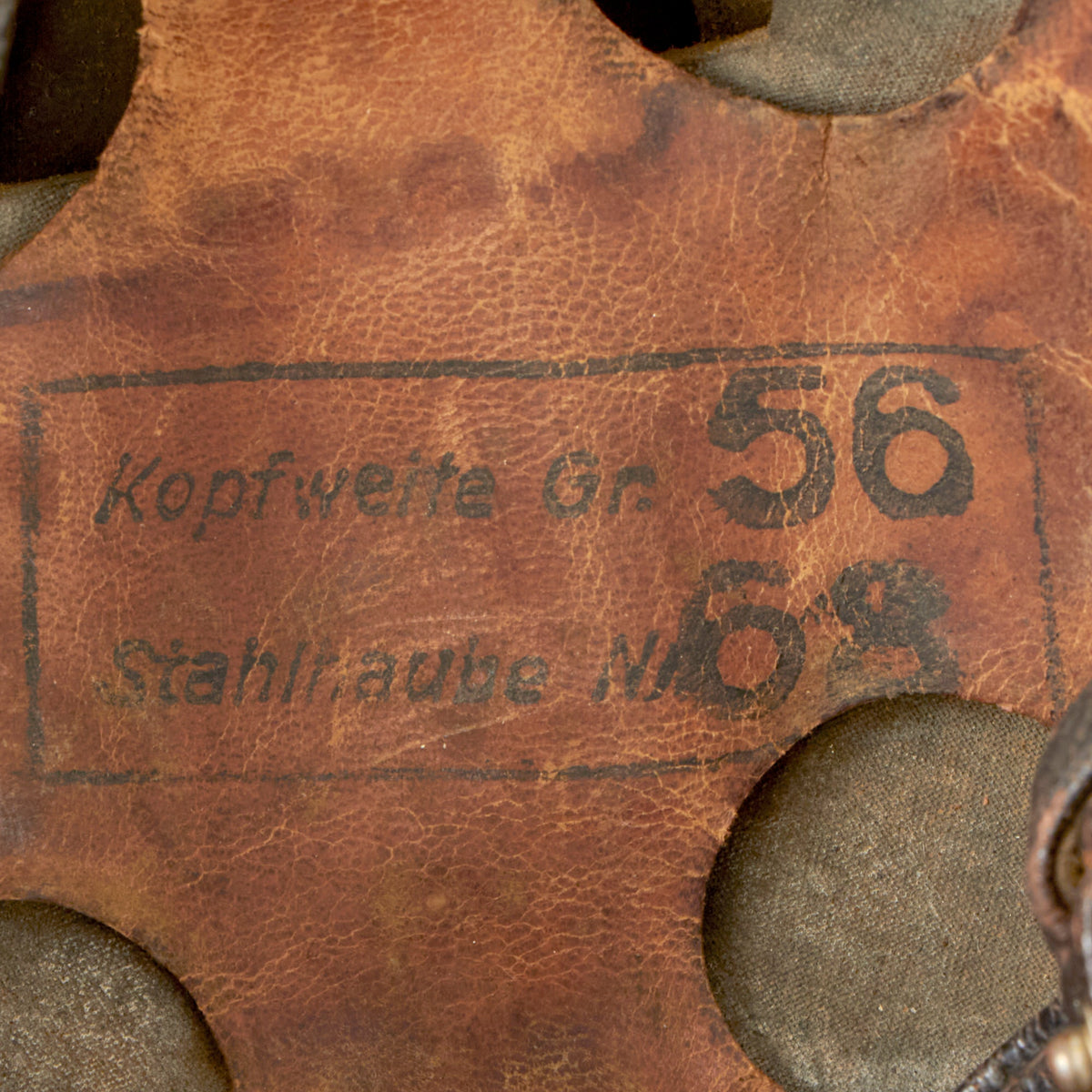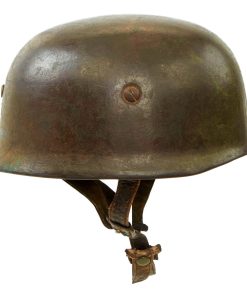Original German WWII 91st ID USGI Captured Italian Camo M-38 Luftwaffe Fallschirmjäger Paratrooper Helmet Marked to FJ Rgt. 12, 3rd Bn. with History – ckl68 Original Items
$ 11.995,00 $ 2.998,75
Original Item: Only One Available. Just acquired from a very well-curated Luftwaffe collection, this is an fantastic example of a WWII German M-38 Fallschirmjäger Helmet, painted with the very desirable “Italian Pattern” camouflage. Similar to the “Normandy Pattern”, it has more browns and tans in the mix, more appropriate for the Mediterranean terrain. It is also complete with liner and chinstraps, showing some great period wear. We almost always see these missing some components, but this example is complete!
Helmets like this do not come about very often, and it has been quite some time since we have had an M38 paratrooper of this quality. This is a mid-war model M-38 with 2nd Pattern Liner and chinstrap fitted to the shell by the means of four slot-headed bolts. We do not see any evidence the liner or chinstraps have ever been removed or modified in any way. This helmet in its entirety looks like it simply has not been touched since it was brought home by an American GI after the war!
In this case, we even have information regarding that, as the collector who purchased it from a WWII veteran was able to get the background information regarding the helmet:
I got this helmet from a veteran that fought along the Gothic Line in the Winter of 1944. The veteran was in Bravo Company 2nd BN 363rd Infantry 91st Infantry Division as it advanced upon the Gothic Line and he picked the helmet up in the Battle for Monte Altuzzo as they pushed on the Giogo Pass. On September 13, 14 and 15 1944 elements of the 3rd BN 12th Fallschirmjäger Regiment were brought forward to defend Giogo Pass and support the 1st BN 12th Fallschirmjäger that were being pounded by the Americans.
On 8 September each soldier in Fallschirmjäger Regiment 12, had received orders that “… the position is to be held to the last man and the last bullet even if the enemy breaks through on all sides as well as against strongest artillery or mortar fire. Only on authority of the company commander may the position be abandoned.”
The veteran was part of a group of 5 or 6 Soldiers that moved forward at twilight on 14 September to scout enemy location and gun emplacements on Monticelli Ridge, above the tree line that overlooked the pass (Giogo) after receiving heavy fire earlier in the day and being stopped in their tracks. After passing out of the trees and working through a number of barbed wire obstacles of waist to ankle height and crawling up a steep slope they identified a gun emplacement dug into the hillside made from heavy timber and brush camouflage. This group of Soldiers found the gun emplacement that had stopped their company advance earlier in the day and reported its location.
On the 15th a US Artillery barrage destroyed the gun emplacement (he said daylight, but research says later in the day). Company B advanced and captured a section of the ridge line and summit, and then defended this section from repeated German counter attacks for two days until the 17th of September. Early on this day the attacks were stopped when the remainder of the defenders, including the elements of the 12th Fallschirmjäger Regiment, were withdrawn.
Company B was severely understrength and was made to link up with Company G. During this link up the veteran went back towards the remains of the gun emplacement that he has scouted on the 14th and as he was approaching he discovered the helmet among the rocks and vegetation near the gun emplacement (and the remains of 3 dead Germans, in Luftwaffe uniforms and one in a splinter jump smock).
He speculated that the helmet belonged to one of the German’s in the gun emplacement as he didn’t think the Germans passed back over that area as they counter-attacked over the 15th 16th and 17th. He stated they lost over 126 men to injuries and death and afterwards they found over 150 dead Germans, captured between 35 and 40, many in Luftwaffe uniforms. He told me of terrifying, intense counterattacks by the German Paratroopers at all hours of the day and that they clearly knew what they were doing and were dedicated to the defense of the ridgeline.
This is the account that came with the helmet, which definitely makes it a great candidate for further research.
Regarding the helmet itself, it still retains much of the Italian Pattern camouflage paint on the exterior, with the interior showing the original Feldgrau (field gray) lightly textured combat finish. It does not look to have had any refinishing done after the camouflage paint was applied, and we do no see any evidence that it had a decal applied at any time. It has a great service used look to it that is impossible to duplicate. This is the real deal, with a fantastic patina, and a great story to go with it.
The rear of the skirt is faintly stamped with ckl68 over a partial lot number, which is quite hard to see, but is totally correct. We even measured the outside of the helmet, and came up with 69cm, correct for a 68 shell. All paratrooper helmets were produced by Eisenhüttenwerk AG of Thale, located in the Harz district in Saxony, Germany. They had used the abbreviation “ET” until about 1942, after which they moved to the three letter code “ckl”. This example is a shell size 68 and was produced some time in 1942 – 1945. The helmet shells were produced in two sizes, 68 and 71, and this is the smaller size 68cm shell with a liner that is sized 56cm.
The liner in the helmet is complete, and has the correct wartime aluminum liner band with foam rubber spacers between the band and the leather of the liner. The rubber is intact, though now has become somewhat stiff with age. The leather liner is complete with no major tears, and now shows a nice russet brown color, showing moderate use. There is some splitting and such along the rim, but no major damage. The original markings are still clear, definitely a rarity! On the rear side of the liner are the correct size markings, inside a box:
Kopfweite: Gr. 56
Stahlhelm: Nr. 68
Towards the front of the helmet the supplier information is also clearly legible:
Karl Heisler
BERLIN C2
D.R.G.M.a
Under this is another marking, giving the name and Luftwaffe Feldpost information of the wearer:
Otto
L-55828c
This Luftwaffe mail number corresponds to the 12. Fallschirmjäger Regiment, III Bataillon, which was part of the 4. Fallschirmjäger-Division. This unit was formed in Venice, Italy, in November 1943, from elements of 2. Fallschirmjäger Division and volunteers from the Italian 184 and 185 Airborne Division Folgore parachute divisions. Its first combat action was against the Allied landings at Anzio (Operation Shingle) as part of the I. Fallschirm Korps in January 1944.
After Anzio, the division fought a rear guard action in front of Rome, and was the last German unit to leave the city on 4 June; it withdrew towards Viterbo Siena Firenze and then managed to halt the Allies at the Futa pass. In the Winter of 1944/1945 it was positioned on the Gothic Line. In March 1945, the Division had to send the II Battalion, 12 Fallschirmjäger Regiment and the 2nd Company from the Pionier Battalion to the new 10 Fallschirmjager Division, which was being formed in Austria. It then fought at Nettuno, Florence, Rimini and Bologna and surrendered to the Allies in April 1945.
The original chinstrap is in very good shape, and still supple. From what we can see it is complete, with all components present, working snaps, and a functional buckle. The straps do show a bit of wear and tear, and there is some pulling at the stitches and small tears on stress points, as to be expected on a helmet that was actually used in service. Given that many of these helmets are completely missing their internal rigging, this is a real treat!
A fantastic mid-war Italian Camouflage Fallschirmjäger with some fantastic history. We are unlikely to have another paratrooper helmet of this quality anytime soon! Ready to add to your collection and display!
Fallschirmjägerhelm M38
Fallschirmjägerhelm M38 ( M38 Heisler / M38 ) – was a German steel paratrooper helmet intended for Fallschirmjäger airborne units from World War II. Originally, the German airborne troops used the standard Stahlhelm M35 helmets throughout the German Army . It soon turned out, however, that this helmet was not suitable for parachuting, as it caused significant air resistance during the jump. A too loosely fastened helmet could have been torn from the jumper’s head, and if it was tightly fastened it could cause suffocation.
Therefore, from 1936, work was carried out at the Eisenhüttenwerke factory to create a helmet dedicated specifically to the airborne troops. Their effect was a parachute helmet designed by engineer Karl Heisler, which under the designation M38 was adopted by the army.
The M38 helmet was derived from the standard M35 helmet. However, it was smaller, more streamlined and with a significantly reduced hood. The front part of the hood was only marked, and the rear part was shortened to 1.8 cm. (in experimental versions – 2 cm). The rims of the bell were rolled up. The helmet bell was made in a series of operations from one piece of steel sheet 1.5 mm thick. It was produced in sizes marked as 66, 68 and 71.
The internal equipment of the experimental versions of the helmet was identical to that of the standard M35 helmet. In the version adopted for equipment, a new type of fascia was used, which better protected against possible injuries. For this purpose, the bell walls were additionally lined with a shock-absorbing micro-rubber insert cut into 7 “arms” with a thickness of 10 to 13 mm. The actual fit was in the form of a leather cap with round holes cut for ventilation. Both the micro-rubber insert and the leather cap were attached to an aluminum rim with a thickness of 1 mm. All interior fittings were bolted with four screws to the helmet bell.
A new type of lining was also used in the parachute helmet. The standard two-point suspension was replaced with a four-point “Y” -shaped suspension, which ensured better fit of the helmet on the head. In the model adopted as an accessory, the straps of the lining were widened to 20 mm and latches were introduced to protect the helmet against accidental unfastening.
The helmet’s bell was initially painted gray-blue. A national-colored shield on the right side and a Luftwaffe eagle decal on the left side were put on. Later during the war, the bell was painted gray-green or sand colored. Various covers and masking nets were also used. In winter conditions, the helmet bell was painted white.
Polish tankers from the 2nd Corps of the Polish Armed Forces in the West would use captured M38 helmets. The reason for this was their small size and the fact that they fit very tightly to the head. However, they were strictly forbidden to use them, as it happened that their own infantry mistook the tankers leaving their vehicles as Germans and opened fire on them.
Fast Shipping with Professional Packaging
Thanks to our longstanding association with UPS FedEx DHL, and other major international carriers, we are able to provide a range of shipping options. Our warehouse staff is expertly trained and will wrap your products according to our exact and precise specifications. Prior to shipping, your goods will be thoroughly examined and securely secured. We ship to thousands clients each day across multiple countries. This shows how we're dedicated to be the largest retailer on the internet. Warehouses and distribution centres can be located throughout Europe as well as the USA.
Note: Orders with more than one item will be assigned a processing date depending on the item.
Before shipping before shipping, we'll conduct a thorough inspection of the items you have ordered. Today, the majority of orders will be delivered within 48 hours. The delivery time will be between 3-7 days.
Returns
The stock is dynamic and we cannot completely manage it because multiple stakeholders are involved, including our factory and warehouse. So the actual stock may alter at any time. It's possible that you may not receive your order once the order has been made.
Our policy is valid for a period of 30 days. If you don't receive the product within 30 days, we are not able to issue a refund or an exchange.
You can only return an item if it is unused and in the same state as the day you received it. You must have the item in its original packaging.
Related products
Uncategorized
Uncategorized
Uncategorized
Uncategorized
Uncategorized
Uncategorized
Uncategorized
Uncategorized
Uncategorized
Uncategorized
Australian WWII Owen MK1 Machine Carbine SMG Custom Fabricated Replica with Sling Original Items
Uncategorized
Armoured Fighting Vehicles of the World: AFVs of World War One (Hardcover Book) New Made Items
Uncategorized
Uncategorized
Uncategorized
Angolan Rebel 1970s era 60mm Inert Display Mortar from Angolan Civil War Original Items
Uncategorized
Uncategorized
Uncategorized
Uncategorized
Uncategorized
Armored Burgonet Helmet & Polearm from Scottish Castle Leith Hall Circa 1700 Original Items












































































